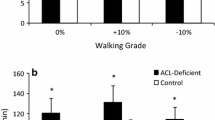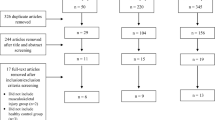Abstract
Purpose
The present experiment was conducted to examine the hypothesis that challenging control through narrow-base walking and/or dual tasking affects ACL-injured adults more than healthy control adults.
Methods
Twenty male ACL-injured adults and twenty healthy male adults walked on a treadmill at a comfortable speed under two base-of-support conditions, normal-base versus narrow-base, with and without a cognitive task. Gait patterns were assessed using mean and variability of step length and mean and variability of step velocity. Cognitive performance was assessed using the number of correct counts in a backward counting task.
Results
Narrow-base walking resulted in a larger decrease in step length and a more pronounced increase in variability of step length and of step velocity in ACL-injured adults than in healthy adults. For most of the gait parameters and for backward counting performance, the dual-tasking effect was similar between the two groups.
Conclusions
ACL-injured adults adopt a more conservative and more unstable gait pattern during narrow-base walking. This can be largely explained by deficits of postural control in ACL-injured adults, which impairs gait under more balance-demanding conditions. The observation that the dual-tasking effect did not differ between the groups may be explained by the fact that walking is an automatic process that involves minimal use of attentional resources, even after ACL injury. Clinicians should consider the need to include aspects of terrain complexity, such as walking on a narrow walkway, in gait assessment and training of patients with ACL injury.
Level of evidence
III.

Similar content being viewed by others
References
Al-Yahya E, Dawes H, Collett J, Howells K, Izadi H, Wade DT, Cockburn J (2009) Gait adaptations to simultaneous cognitive and mechanical constraints. Exp Brain Res 199:39–48
Alkjaer T, Simonsen EB, Jorgensen U, Dyhre-Poulsen P (2003) Evaluation of the walking pattern in two types of patients with anterior cruciate ligament deficiency: copers and non-copers. Eur J App Physiol 89:301–308
Balasubramanian CK, Clark DJ, Fox EJ (2014) Walking adaptability after a stroke and its assessment in clinical settings. Stroke Res Treat 2014:591013
Bauby CE, Kuo AD (2000) Active control of lateral balance in human walking. J Biomech 33:1433–1440
Bonfim TR, Grossi DB, Paccola CA, Barela JA (2008) Additional sensory information reduces body sway of individuals with anterior cruciate ligament injury. Neurosci Lett 441:257–260
Calliess T, Bocklage R, Karkosch R, Marschollek M, Windhagen H, Schulze M (2014) Clinical evaluation of a mobile sensor-based gait analysis method for outcome measurement after knee arthroplasty. Sensors (Basel) 14:15953–15964
Deshpande N, Zhang F (2014) Trunk, head, and step characteristics during normal and narrow-based walking under deteriorated sensory conditions. J Motor Behav 46:125–132
Ferber R, Osternig LR, Woollacott MH, Wasielewski NJ, Lee J-H (2002) Gait mechanics in chronic ACL deficiency and subsequent repair. Clin Biomech (Bristol, Avon) 17:274–285
Friden T, Roberts D, Ageberg E, Walden M, Zatterstrom R (2001) Review of knee proprioception and the relation to extremity function after an anterior cruciate ligament rupture. J Orthop Sports Phys Ther 31:567–576
Gao B, Zheng NN (2010) Alterations in three-dimensional joint kinematics of anterior cruciate ligament-deficient and -reconstructed knees during walking. Clin Biomech (Bristol, Avon) 25:222–229
Hausdorff JM, Rios DA, Edelberg HK (2001) Gait variability and fall risk in community-living older adults: a 1-year prospective study. Arch Phys Med Rehabil 82:1050–1056
Kelly VE, Schrager MA, Price R, Ferrucci L, Shumway-Cook A (2008) Age-associated effects of a concurrent cognitive task on gait speed and stability during narrow-base walking. J Gerontol A Biol Sci Med Sci 63:1329–1334
Knoll Z, Kocsis L, Kiss RM (2004) Gait patterns before and after anterior cruciate ligament reconstruction. Knee Surg Sports Traumatol Arthrosc 12:7–14
Lamoth C, Stins J, Pont M, Kerckhoff F, Beek P (2008) Effects of attention on the control of locomotion in individuals with chronic low back pain. J Neuroeng Rehabil 5:13
Mazaheri M, Roerdink M, Bood RJ, Duysens J, Beek PJ, Peper CL (2014) Attentional costs of visually guided walking: effects of age, executive function and stepping-task demands. Gait Posture 40:182–186
Mentiplay BF, Perraton LG, Bower KJ, Pua YH, McGaw R, Heywood S, Clark RA (2015) Gait assessment using the Microsoft Xbox One Kinect: concurrent validity and inter-day reliability of spatiotemporal and kinematic variables. J Biomech 48:2166–2170
Negahban H, Ahmadi P, Salehi R, Mehravar M, Goharpey S (2013) Attentional demands of postural control during single leg stance in patients with anterior cruciate ligament reconstruction. Neurosci Lett 556:118–123
Negahban H, Hadian MR, Salavati M, Mazaheri M, Talebian S, Jafari AH, Parnianpour M (2009) The effects of dual-tasking on postural control in people with unilateral anterior cruciate ligament injury. Gait Posture 30:477–481
Negahban H, Mazaheri M, Kingma I, van Dieen JH (2014) A systematic review of postural control during single-leg stance in patients with untreated anterior cruciate ligament injury. Knee Surg Sports Traumatol Arthrosc 22:1491–1504
Negahban H, Mostafaee N, Sohani SM, Mazaheri M, Goharpey S, Salavati M, Zahednejad S, Meshkati Z, Montazeri A (2011) Reliability and validity of the Tegner and Marx activity rating scales in Iranian patients with anterior cruciate ligament injury. Disabil Rehabil 33:2305–2310
Parvataneni K, Ploeg L, Olney SJ, Brouwer B (2009) Kinematic, kinetic and metabolic parameters of treadmill versus overground walking in healthy older adults. Clin Biomech (Bristol, Avon) 24:95–100
Relph N, Herrington L, Tyson S (2014) The effects of ACL injury on knee proprioception: a meta-analysis. Physiotherapy 100:187–195
Rudolph KS, Axe MJ, Buchanan TS, Scholz JP, Snyder-Mackler L (2001) Dynamic stability in the anterior cruciate ligament deficient knee. Knee Surg Sports Traumatol Arthrosc 9:62–71
Salavati M, Mazaheri M, Negahban H, Sohani SM, Ebrahimian MR, Ebrahimi I, Kazemnejad A, Salavati M (2008) Validation of a Persian-version of Knee injury and Osteoarthritis Outcome Score (KOOS) in Iranians with knee injuries. Osteoarthr Cartil 16:1178–1182
Schrager MA, Kelly VE, Price R, Ferrucci L, Shumway-Cook A (2008) The effects of age on medio-lateral stability during normal and narrow base walking. Gait Posture 28:466–471
Shabani B, Bytyqi D, Lustig S, Cheze L, Bytyqi C, Neyret P (2015) Gait changes of the ACL-deficient knee 3D kinematic assessment. Knee Surg Sports Traumatol Arthrosc 23:3259–3265
Sloot LH, van der Krogt MM, Harlaar J (2014) Self-paced versus fixed speed treadmill walking. Gait Posture 39:478–484
Woollacott M, Shumway-Cook A (2002) Attention and the control of posture and gait: a review of an emerging area of research. Gait Posture 16:1–14
Acknowledgments
This study is a part of the master thesis of Maryam Soltani, financially supported by Ahvaz Jundishapur University of Medical Sciences (grant no pht-9014).
Author information
Authors and Affiliations
Corresponding author
Rights and permissions
About this article
Cite this article
Mazaheri, M., Negahban, H., Soltani, M. et al. Effects of narrow-base walking and dual tasking on gait spatiotemporal characteristics in anterior cruciate ligament-injured adults compared to healthy adults. Knee Surg Sports Traumatol Arthrosc 25, 2528–2535 (2017). https://doi.org/10.1007/s00167-016-4014-4
Received:
Accepted:
Published:
Issue Date:
DOI: https://doi.org/10.1007/s00167-016-4014-4




